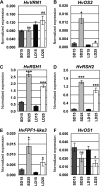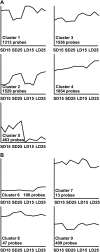Identification of high-temperature-responsive genes in cereals
- PMID: 22279145
- PMCID: PMC3291267
- DOI: 10.1104/pp.111.192013
Identification of high-temperature-responsive genes in cereals
Abstract
High temperature influences plant development and can reduce crop yields. We examined how ambient temperature influences reproductive development in the temperate cereals wheat (Triticum aestivum) and barley (Hordeum vulgare). High temperature resulted in rapid progression through reproductive development in long days, but inhibited early stages of reproductive development in short days. Activation of the long-day flowering response pathway through day-length-insensitive alleles of the PHOTOPERIOD1 gene, which result in high FLOWERING LOCUS T-like1 transcript levels, did not allow rapid early reproductive development at high temperature in short days. Furthermore, high temperature did not increase transcript levels of FLOWERING LOCUS T-like genes. These data suggest that genes or pathways other than the long-day response pathway mediate developmental responses to high temperature in cereals. Transcriptome analyses suggested a possible role for vernalization-responsive genes in the developmental response to high temperature. The MADS-box floral repressor HvODDSOC2 is expressed at elevated levels at high temperature in short days, and might contribute to the inhibition of early reproductive development under these conditions. FLOWERING PROMOTING FACTOR1-like, RNase-S-like genes, and VER2-like genes were also identified as candidates for high-temperature-responsive developmental regulators. Overall, these data suggest that rising temperatures might elicit different developmental responses in cereal crops at different latitudes or times of year, due to the interaction between temperature and day length. Additionally, we suggest that different developmental regulators might mediate the response to high temperature in cereals compared to Arabidopsis (Arabidopsis thaliana).
Figures








References
-
- Aspinall D. (1969) The effects of day length and light intensity on the growth of barley. Aust J Biol Sci 22: 53–67
-
- Asseng S, Foster I, Turner N. (2011) The impact of temperature variability on wheat yields. Glob Change Biol 17: 997–1012
-
- Beales J, Turner A, Griffiths S, Snape JW, Laurie DA. (2007) A pseudo-response regulator is misexpressed in the photoperiod insensitive Ppd-D1a mutant of wheat (Triticum aestivum L.). Theor Appl Genet 115: 721–733 - PubMed
-
- Benjamini Y, Hochberg Y. (1995) Controlling the false discovery rate—a practical and powerful approach to multiple testing. J R Stat Soc Ser B Methodol 57: 289–300
Publication types
MeSH terms
Substances
Associated data
- Actions
- Actions
- Actions
- Actions
- Actions
- Actions
- Actions
- Actions
- Actions
- Actions
- Actions
- Actions
- Actions
LinkOut - more resources
Full Text Sources
Molecular Biology Databases

